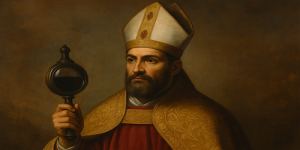Who was St. Januarius?
Little is known about the saint’s life, but legend and tradition remain strong. Januarius was bishop of Benevento in the 4th century, during the brutal persecutions of Christians under Emperor Diocletian. Refusing to sacrifice to Roman gods, he was arrested with friends. According to accounts, they were thrown to wild beasts, which did them no harm. Eventually, all were beheaded (Trwajcie w miłości).
After his martyrdom, a pious woman named Eusebia is said to have collected his blood in glass vials—now among the most treasured relics in Naples (Breviary).
A Miracle that Unites Crowds
The procession of St. Januarius’ relics is a moving event, drawing even those who rarely enter a church. Within the crowd, you’ll hear stories of families who, for generations, have come to pray for healing, peace, or a miracle. When the blood liquefies—sometimes slowly, sometimes suddenly—the archbishop raises the reliquary, turning it for all to see. The “Te Deum” hymn swells, and the faithful approach to venerate the relic and give thanks.
“When I see this miracle, I feel closer to God. It’s a sign He’s with us, here and now,” said Maria, a Polish pilgrim quoted in the local press.
Miracle and Science—What Do Researchers Say?
Scientists have long tried to explain the liquefaction phenomenon. Spectroscopic studies, chemical analyses, and laboratory simulations have all been attempted. While some hypotheses (such as thixotropy—the property of some gels to become liquid when agitated) have been proposed, none fully explain the regularity or suddenness of the transformation witnessed by thousands (Polish Radio).
Does the Miracle Always Occur?
Most years, the blood does liquefy, but there have been times when it remained solid. In Naples, this is seen as an omen of misfortune—war, epidemic, or disaster. This happened in 1944 before the devastating eruption of Vesuvius, and during outbreaks of cholera (Niedziela).
A Living Faith
The miracle of St. Januarius’ blood reminds us that God often uses the tangible—relics, signs—to touch our hearts and enliven faith. For many, witnessing the miracle is a moment of profound transformation and reflection on the mystery of life, death, and resurrection.
“St. Januarius’ blood is a clot that lives and breathes: not some alienating piety, but a sign of eternal life and resurrection,” said a local priest (Modlitwa w Drodze).
The Miracle and the Eucharist
The Church sees in the miracle of St. Januarius a foreshadowing of an even greater mystery: the Eucharist, in which Christ is truly present in Body and Blood. Just as the liquefied blood inspires awe, so the Holy Communion remains the “greatest miracle” for believers, offering eternal life.
Why Witness It?
To witness this miracle is deeply moving—whether you look at it through the lens of faith or science. “Let this miracle remind us that faith is alive and God acts today,” Neapolitans say.






















